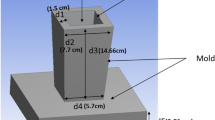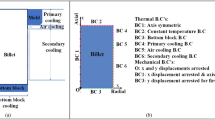Abstract
There are casting defects caused by insufficient behaviors of heat transfer and solidification, such as a shrinkage cavity and porosity. To obtain a sound casting, the prediction of the location and size of defects using the casting CAE simulation is a useful and effective method. As the current defect prediction in casting CAE is limited to qualitative evaluation, it is necessary to predict defects quantitatively. Conical mold castings are suited for predictive verification of simulations because they are prone to shrinkage cavity defects. This study performed shrinkage evaluation experiments on aluminum alloys using a conical mold. The pipe-like internal shrinkage that occurred in the center of the casting originates from the reinstallation of the stopper, and it clarified that breaking the oxide film affects the internal shrinkage. Further, the shrinkage cavities were estimated using Eulerian and Lagrangian casting CAE software. Comparison with experimental results showed that it is difficult to match the boundary conditions in the simulations to the actual phenomena.















Similar content being viewed by others
References
E. Fiorese, F. Bonollo, G. Timelli et al., New classification of defects and imperfections for aluminum alloy castings. Inter Metalcast 9, 55–66 (2015). https://doi.org/10.1007/BF03355602
I. Ohnaka, Y. Mori, Y. Nagasaka, T. Fukusako, Numerical analysis of shrinkage cavity formation without solid phase movement. IMONO 53, 673–679 (1981). https://doi.org/10.11279/imono.53.12_673
T. Wang, X. Shen, J. Zhou et al., Optimal gating system design of steel casting by fruit fly optimization algorithm based on casting simulation technology. Inter Metalcast 13, 561–570 (2019). https://doi.org/10.1007/s40962-018-0291-7
M. Raza, R. Svenningsson, M. Irwin et al., Effects of process related variations on fillablity simulation of thin-walled IN718 structures. Inter Metalcast 12, 543–553 (2018). https://doi.org/10.1007/s40962-017-0189-9
Y. Awano, K. Morimoto, Shrinkage morphology of Al–Si casting alloys. Int. J. Cast Met. Res. 17, 107–114 (2004). https://doi.org/10.1179/136404604225014846
Nonferrous Castings Research Subcommittee, ed. Report of Nonferrous Castings Research Subcommittee 1990 (Tokai Branch of Japan Foundry Association, 1990), pp. 1–70
Japan Foundry Engineering Society, Research Report No. 113 (2014), pp. 133–185
J. Campbell, Castings, 2nd ed (Butterworth Heinemann, 2003), pp. 14–70. https://doi.org/10.1016/B978-0-7506-4790-8.X5016-5
A. Ando, K. Haza, Casting simulation soft TopCAST. J. Jpn. Found. Eng. Soc. 86, 946–950 (2014). https://doi.org/10.11279/jfes.86.946
I. Takahashi, Casting simulation. J. Jpn. Found. Eng. Soc. 92, 705–708 (2020). https://doi.org/10.11279/jfes.92.705
M.Y. Hu, J.J. Cai, N. Li et al., Flow modeling in high-pressure die-casting processes using SPH model. Inter Metalcast 12, 97–105 (2018). https://doi.org/10.1007/s40962-017-0144-9
Y. Sakai, Application of SPH to predict shrinkage cavity in castings. J. Jpn. Found. Eng. Soc. 92, 278–284 (2020). https://doi.org/10.11279/jfes.92.278
M. Ichimiya, Y. Sakai, Development of filling and solidification simulation using smoothed particle hydrodynamics. J. Jpn. Found. Eng. Soc. 85, 481–488 (2013). https://doi.org/10.11279/jfes.85.481
H. Ito, Y. Maeda, A. Murakami, Mold filling simulation using MARS method for thin castings. J. Jpn. Found. Eng. Soc. 89, 167–173 (2017). https://doi.org/10.11279/jfes.89.167
T. Vossel, N. Wolff, B. Pustal et al., Heat Transfer coefficient determination in a gravity die casting process with local air gap formation and contact pressure using experimental evaluation and numerical simulation. Inter Metalcast 16, 595–612 (2022). https://doi.org/10.1007/s40962-021-00663-y
K. Ohura, A. Makinouchi. Cristian Teodosiu, Solidification simulation with consideration of local variation of heat transfer coefficient caused by air-gap generation. J. Jpn. Found. Eng. Soc. 79, 656–664 (2007). https://doi.org/10.11279/jfes.79.656
F. Kinoshita, Latest trends of casting simulation software JSCAST. J. Jpn. Found. Eng. Soc. 86, 927–930 (2014). https://doi.org/10.11279/jfes.86.927
Author information
Authors and Affiliations
Corresponding author
Additional information
Publisher's Note
Springer Nature remains neutral with regard to jurisdictional claims in published maps and institutional affiliations.
This paper is an invited submission to IJMC selected from presentations at the 74th World Foundry Congress, held October 16–20, 2022, in Busan, Korea, and has been expanded from the original presentation.
Rights and permissions
Springer Nature or its licensor (e.g. a society or other partner) holds exclusive rights to this article under a publishing agreement with the author(s) or other rightsholder(s); author self-archiving of the accepted manuscript version of this article is solely governed by the terms of such publishing agreement and applicable law.
About this article
Cite this article
Nishihara, T., Nakamura, Y. & Maeda, Y. Shrinkage Cavities in Conical Mold Castings of Aluminum Alloy. Inter Metalcast 17, 2431–2438 (2023). https://doi.org/10.1007/s40962-023-00973-3
Received:
Accepted:
Published:
Issue Date:
DOI: https://doi.org/10.1007/s40962-023-00973-3




